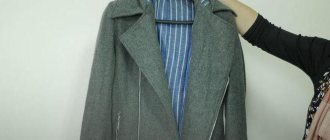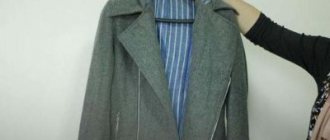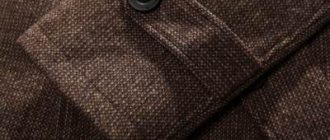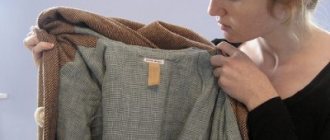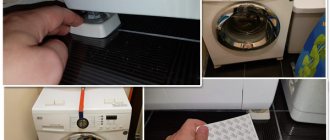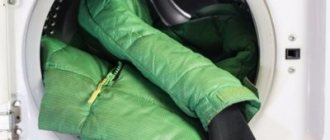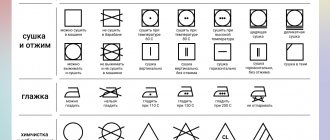During long-term storage in a closet or after improper washing, a coat may become wrinkled and lose its attractive appearance.
In such situations, it becomes necessary to iron outerwear. But how to properly iron a coat?
In order not to spoil the product, it is important to know some rules for caring for it, depending on the type of material from which it is made.
We look at the label and follow the recommendations
| Material | Temperature | Recommendations |
| Drape | 140–165 °C | The fabric is difficult to iron, it is better to use steaming |
| Wool | 115–140 °C | Iron through damp cotton cloth |
| Cashmere | Ironing is prohibited | Steam treatment is allowed at a distance of 2-3 cm |
| Polyester | Silk mode | Iron with care, pressing the iron lightly |
| Gabardine | 60-85 °C | Iron from the inside out through cotton fabric |
| Synthetics | Minimum mode | Iron with a low-heat iron using light touches |
| Suede | Ironing is prohibited | Vertical steaming with an iron or steamer is allowed |
| Velveteen | up to 110 °C | Iron from the inside out. Use multi-layer lining |
Mechanical and thermal recovery method
You can restore shrunken clothing by mechanically stretching it with your hands or by attaching it to a mannequin of a suitable size.
- You need to start working by soaking the deformed product in warm water for 15-20 minutes.
- After this time, the woolen item is removed from the container and laid out on a wire rack located above the bathtub or basin.
- When the excess liquid has drained, the product is dried a little, wrapped in a terry towel, and then pulled onto the prepared mannequin.
- While the sweater is drying, you need to periodically come up and pull the sleeves and fronts down.
To stretch a wool hat, just soak it in warm water, add a little shampoo or conditioner, and stretch it onto a 3-liter jar. The product will dry and acquire the desired size.
Sometimes the problem can be solved by steaming with an iron. The ironing board is covered with damp gauze. A woolen product is laid out on it, covered with another layer of wet fabric and steamed with an iron. When wet material is heated, a powerful stream of steam is formed, which passes through the wool, slightly pushing the fibers apart.
Features of ironing depending on the material
Modern coats are made from a variety of fabrics. They are more difficult to iron than blouses or skirts, since many parts of the product are glued with interlining materials to add rigidity. If strong folds have formed, then too intense ironing can ruin the fabric on the front side.
Drape
Coats made of this material are dense and warm, since they contain wool. The fabric is usually two-layer, with or without pile. Before use, you need to moisten it with a spray bottle.
- Place the product on a flat surface. If the fabric is brushed, cover the ironing board with a terry towel or brushed material so as not to injure the fibers of the drape.
- Iron small parts.
- Iron the back and front from the inside out using a damp iron (or cotton fabric).
- Turn the product inside out and turn on the steam mode. Process without almost touching the fabric.
Note! It is not recommended to put on ironed clothes right away, as the fabric will quickly wrinkle and the product will lose its shape. For the material to “calm down”, you need to wait 8-10 hours.
Pile fabrics should be ironed through a pile iron (for example, through a piece of velvet).
Wool
Before ironing a wool coat, you need to check the reaction of the material to a hot iron from the inside or on the attached patch.
When working, use a linen iron, but it is better to use a woolen one. To prevent the fabric from being deformed, cover the area to be treated with a dry wool flap, and a damp one over it. Turn on the iron and begin the operation:
- Smooth out small parts.
- Process the sleeves by placing them on a special stand. If it is not there, roll up a terry towel and put it inside the part.
- Turn the product inside out and iron it.
- Process the front side using an ironing iron.
- Smooth the shoulder part by placing a bundle of towel or a small pillow inside.
- When ironing, do not press too hard with the iron, otherwise fingerprints will remain.
- If you need to steam, do it barely touching, but it’s better to do it remotely.
- Before putting on clothes, they should be allowed to “rest” for 2-3 hours.
Cashmere
The material is one of the expensive and capricious fabrics. It is recommended to iron from the wrong side, from the front - ironing is prohibited, steam treatment is allowed at a distance of 2-3 cm.
Start with small parts: pockets, flaps, straps. Then process the sleeves, back and fronts using an ironing iron made of a material with a similar composition.
When ironing a coat from the wrong side, you can do without gauze.
Polyester
Products made from synthetic fabrics do not tolerate high temperatures. When ironing, you must carefully straighten the slightest wrinkles so that creases in the fabric do not form. If an error occurs, it will be difficult to correct the defect.
Gabardine
The material is thin, used for sewing spring and autumn coats. Smooth out bruises especially carefully using a damp iron.
To avoid water drips, it must be squeezed out well and ironed. Or moisten the flap with a spray bottle. Iron the moistened coat until completely dry so that the parts do not become deformed.
Synthetics
Clothes made from this fabric practically do not wrinkle. But if this happens, ironing the coat will be problematic. But in some cases, it is possible to return the normal appearance of a synthetic coat.
You need to iron capricious fabric by setting the appropriate mode. To begin with, try it on an inconspicuous area. If you are afraid that marks will remain, protect the sole of the iron with a Teflon nozzle. Leave the ironed item on a hanger until it cools completely.
Note! If the product label indicates that ironing is prohibited, then hot steam treatment will help remove the bruises. To do this, you can use a steam generator or an iron with a vertical steam function.
Before ironing your coat, you need to hang it on hangers. Holding the iron at a distance of 10-15 cm, treat the bruises with a stream of steam. Wait a couple of seconds, move to the next section, moving from top to bottom. After finishing the treatment, leave the coat on a hanger until it cools completely and dries. Keep away from radiators and other heat sources.
Suede
It is not recommended to iron coats made of natural material and pile fabric. In case of severe bruises, treatment with a barely heated iron is allowed. You can get rid of creases by steaming at a distance using an iron or steam generator. It is recommended to keep the product in a vertical position.
Velveteen
It is recommended to iron a coat without lining on the reverse side, also in a hanging position, after moistening it first. When processing on a board, be sure to place a pile material (such as velvet).
Combined materials
Before steaming a coat made of complex fabric at home, you need to check its composition on the label.
When choosing the heating mode of the iron, you should focus on the most delicate material. Having set the appropriate temperature, iron the piece of fabric (can be sewn from the inside or packaged in a separate bag with spare buttons).
Is it possible?
When sewing this popular outerwear, designers use different materials, including:
- suede,
- skin,
- velours,
- velveteen.
If the product is made from this raw material, it is better not to iron the coat, but to have it dry cleaned.
Most often, such outerwear is made from natural wool or synthetic materials that can be ironed at home. Any creases and folds can be smoothed out; it is enough to know the specifics of such care for the product.
Ironing Tips
Frequent ironing is not recommended for outerwear, so it is better to avoid bruising. If, despite all precautions, it still loses its appearance, then you need to iron it in accordance with the recommendations:
- It is best to iron in a well-lit room during the daytime. The window should be on the left, the socket on the right.
- Before processing the collar, check for stains. Delete if they exist.
- If clothes have raised embroidery, it is better to smooth out the decor with steam so as not to wrinkle it.
- Knitted coats with a relief pattern are steam ironed while hanging. If necessary, on the table through a moistened iron, without pressure.
- Iron tweed items in the same way as wool items.
- If the product has decor or accessories made of delicate materials, then before steaming the coat, they must be covered with shreds.
- Before ironing the folds on a synthetic coat, they must be carefully straightened. It will be impossible to correct incorrectly ironed areas.
- Satin and twill linings are smoothed dry, as they lose their shine when wet.
- It is recommended to smooth the seams with the edge of the iron.
- To prevent the seams from imprinting when ironing a coat without a lining, you need to place strips of paper under them.
Why does wool shrink after washing?
Every person has a woolen sweater or jacket in their wardrobe. And if this article is studied, then we can conclude that the washing regime was violated and the item shrunk. What to do if a coat or sweater made of pure wool shrinks, how can you return the product to its attractive appearance and stretch it to its previous size?
To decide what to do next with a shrunken item, you must first understand why woolen items shrink so much and sometimes shrink by a couple of sizes. The following factors negatively affect woolen items:
- Washing water temperature is too high. Such clothes should be washed in cool water, the temperature of which does not exceed 30 degrees. Only in this case will it be possible to preserve the original appearance of the clothes.
- Aggressive detergents. Conventional washing powders contain various chemical elements that have a bad effect on wool fibers. To wash such items, you should only use soft detergents that have a mark on them. That they are intended for delicate fabrics.
- Washing woolen items in an inappropriate mode. Modern washing machines are equipped with a delicate operating mode. Therefore, wool and silk should be washed at low speeds and not wrung out too much.
If a woolen sweater or coat was washed at temperatures above 30 degrees, then it is understandable that they shrunk.
Before washing delicate fabrics, be sure to read the instructions on the label.
Is it possible to iron a coat without an iron?
When it is not possible to use technology, you can also return clothes to their normal appearance. There are ways to iron a wrinkled coat without an iron. One option is to moisten it with a spray bottle and let it hang.
The ideal option is to keep it on the balcony in inclement weather (during fog or drizzle). The air saturated with moisture will saturate the fabric, its fibers will swell and straighten. Plus, pollution will disappear.
Another option to deal with wrinkles on your coat is to hang it over a bathtub with hot water or immediately after taking a shower. The steam will soften the wrinkles and they will smooth out on their own. All that remains is to take the coat into the room to dry.
In order not to subject your coat to unnecessary tests, you need to properly care for it. To do this, keep it on hangers, do not press it in the closet with other clothes. Put away for storage, neatly straightened and buttoned.
A wool jacket that has shrunk - let's stretch it on the carpet
To reliably and safely stretch the jacket without losing its shape, we will use the “grandmother’s” method. It will require a solution of the following ingredients:
- 5 liters of cold water;
- 5 tablespoons of ammonia;
- 1 tablespoon of turpentine;
- 1 tablespoon cologne.
Operating procedure:
- Soak the affected product for an hour and a half in the solution.
- Rinse in clean water at the same temperature and squeeze a little.
- Baste the jacket to a piece of thick fabric. To do this, spread a cloth on the table - a tablecloth, a sheet folded in 4 layers, a terry towel. Lay the jacket on top of the fabric, stretch it with your hands and begin sewing it along the contour to the fabric below. Make stitches in 2 cm increments. While sewing, constantly adjust the position of the jacket.
- Stretch the fabric to which the jacket is sewn onto the frame (as indicated in the original recipe). In modern realities, you can do it simpler: lay out the fabric with the jacket on a cleaned rug and attach it to it with pins, pulling it tightly. To do this, you will need a helper to hold the fabric taut while you pin it to the carpet.
- Dry your jacket this way.
Precautionary measures:
- this method is absolutely not suitable if there are small children or playful animals in the house;
- count and write down the number of pins used: you should collect the same number later.
How to get rid of unpleasant odor on new clothes?
If your clothes smell very musty, you can first soak them in water with vinegar. This will help eliminate not only mustiness from clothes, but also many other unpleasant odors. Instead of vinegar, you can add a glass of soda to the water.
Interesting materials:
How much citric acid is needed for cleaning? How many lemons do you need to clean a washing machine? How many lemons do you need to clean a washing machine? How much citric acid does it take to clean a kettle? How much citric acid is needed to clean a kettle? How much citric acid is needed to clean a coffee machine? How much citric acid is needed to clean a washing machine? How much citric acid do you need to clean your iron? How much vinegar does it take to clean a kettle? How much vinegar does it take to clean a washing machine?
